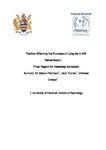Factors Affecting the Success of Long-term ABI Rehabilitation Final Report for Headway Somerset
| dc.contributor.author | Norman, Alyson | |
| dc.contributor.author | Turner, J | |
| dc.contributor.author | Orman, M | |
| dc.contributor.other | Headway Somerset | |
| dc.date.accessioned | 2017-11-22T12:50:11Z | |
| dc.date.available | 2017-11-22T12:50:11Z | |
| dc.date.issued | 2017-07-30 | |
| dc.identifier.uri | http://hdl.handle.net/10026.1/10252 | |
| dc.description.abstract |
Post-acute ABI rehabilitation is incredibly important to the long-term recovery of ABI survivors, with client involvement resulting in a more tailored service. An evaluation of the effectiveness of existing rehabilitation programs was conducted. Inter-rater reliability measures and correlational analysis were used to assess the impact of different demographic factors on the effectiveness of rehabilitation programs. The study predicted that there would be a significant degree of inter-rater reliability in the coding of clients’ rehabilitation goals and that the factors of time between injury and rehabilitation, and time since injury would be significantly correlated with rehabilitation success. One-hundred-and-one clients from Headway Somerset, between 19 to 81 years of age, were included in the analysis. Results showed that the inter-rater reliability for statement categorising was acceptable and that rehabilitation success was positively correlated to both age category and time since injury, but not time between injury and referral. Of these two predictors, time since injury was not beneficial to a regression model in comparison to age category, which significantly predicts average rehabilitation success. The results of this study show that both ABI related factors and individual differences between service users play an important role in the success of long term ABI rehabilitation services. Through the personalisation to individuals, improvements to services can be made. | |
| dc.language.iso | en | |
| dc.title | Factors Affecting the Success of Long-term ABI Rehabilitation Final Report for Headway Somerset | |
| dc.type | report | |
| plymouth.confidential | false | |
| dc.identifier.doi | 10.13140/RG.2.2.24397.13287 | |
| plymouth.organisational-group | /Plymouth | |
| plymouth.organisational-group | /Plymouth/Faculty of Health | |
| plymouth.organisational-group | /Plymouth/REF 2021 Researchers by UoA | |
| plymouth.organisational-group | /Plymouth/REF 2021 Researchers by UoA/UoA04 Psychology, Psychiatry and Neuroscience | |
| plymouth.organisational-group | /Plymouth/Research Groups | |
| plymouth.organisational-group | /Plymouth/Research Groups/Centre for Brain, Cognition and Behaviour (CBCB) | |
| plymouth.organisational-group | /Plymouth/Research Groups/Centre for Brain, Cognition and Behaviour (CBCB)/Behaviour | |
| plymouth.organisational-group | /Plymouth/Users by role | |
| plymouth.organisational-group | /Plymouth/Users by role/Academics | |
| dc.rights.embargoperiod | Not known | |
| rioxxterms.versionofrecord | 10.13140/RG.2.2.24397.13287 | |
| rioxxterms.licenseref.uri | http://www.rioxx.net/licenses/all-rights-reserved | |
| rioxxterms.type | Technical Report |


